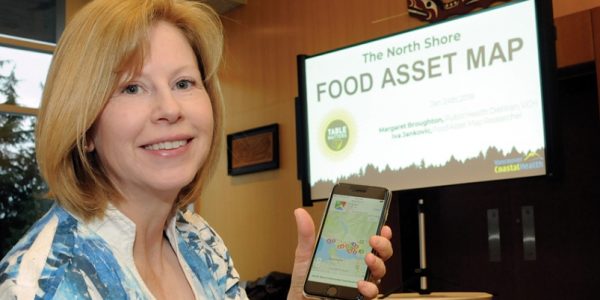Population Health: Food security and the North Shore
This is the third installment in our five-part series on the North Shore Population Health team.
Given the wealth of nutritional information available at our fingertips, you’d think we’d all be able to make the right decisions about what we put in our bodies.
From her years working in community health, public health dietitian Margaret Broughton knows that is simply not true.
“Information is not all you need when it comes to feeding yourself and your children well,” says Margaret. “Many kinds of barriers exist, for example: financial, cultural, skill, experience, time, health status, isolation, marketing practices, proliferation of processed low nutrient food, globalization, transportation and physical access to healthy foods. These are all components that play into food security.”
Margaret has been involved in addressing food security issues since 2006 when the B.C. government revised the Public Health Act and made food security a public health program, giving health authorities a mandate to work on the issue.
As it happens, Margaret had just completed a Masters degree in health care and epidemiology, with a thesis on the connections between household food security and nutritional status in children.
“I got the opportunity to work on this topic in a big picture way,” says Margaret. “My work in food security is related to building community capacity to overcome the barriers listed above with a focus on vulnerable populations such as children.
Wealthy area, but many still at risk
The North Shore may have a reputation for being a wealthy and healthy region, but Margaret says that can mask the community’s problems.
“The basic needs of some North Shore residents, such as food and shelter, are often invisible and affected residents are at risk of being overlooked,” says Margaret. “There is a considerable proportion of vulnerable populations on the North Shore that are living with food insecurity to the point that a growing number of residents and families now rely on local charitable food services for regular access to food.”
To address food insecurity on the North Shore, Margaret has been spearheading a number of projects, including chairing North Shore Table Matters for the last 10 years. It is a community network of organizations and individuals who share an interest in food and food security issues with the intent of making food security a reality on the North Shore.
Food asset map charts food resources
A more recent milestone for Margaret and Table Matters was the creation of the North Shore Community Food Asset Map, which lists North Shore organizations that offer services and goods such as low-cost meals, subsidized groceries, community gardens, food assistance programs, school breakfast programs, grocery retail stores, and more.
Table Matters, together with all North Shore municipalities, school districts and Squamish and Tsleil Waututh First Nations, also created the North Shore Food Charter.
One group that has benefited from Margaret’s expertise and VCH community funding is Harvest Project, says its executive director Gary Ansell.
“From day one, Vancouver Coastal Health has been a partner and an invaluable resource for Harvest Project.”
Food culture ‘crux’ of the problem
“We feel that ‘food culture’ is the crux of the problem as that involves how we relate to food itself, our commercial food system, food from our natural environment and through food to others, applying skills, knowledge and practices,” she says.
Margaret invites VCH staff to consider what kind of food culture we envision that expresses our values about food? How do we obtain, provide and share food in our programs in a way that nourishes individuals, families and builds the community?
“This kind of thinking will help us move beyond providing information and towards overcoming the many barriers to community food security,” says Margaret.
Food security fast facts
- Studies are showing a link between household food insecurity and health care costs
- Nutrition and food security are among the top 4 social indicators of health in Canada, with limited access to nutritious, affordable food linked to poor health, according to the Canadian Medical Association’s What Makes Us Sick?2013 report.
- One in four children live in poverty on the North Shore
- The latest statistics from the VCH Surveillance unit from the My Health My Community Survey indicates less than 30% of adults consume 5+ vegetables and fruits per day. The number 1 vegetable consumed is french fries in most studies.
- Food wastage represents a missed opportunity to improve food security and comes at a steep environmental price.
- With no agricultural land reserve and little food production, the North Shore food system is far from sustainable. It is vulnerable to environmental impacts such as urbanization, wild habitat destruction, shoreline degradation, and greenhouse gas emissions that contribute to global warming.
For more information, contact Margaret at margaret.broughton@vch.ca.
See related stories:
- Population Health: What is it? Find out in this five-part series
- Population Health: Congregate Meals Program provides nutrition and social connection
- Population Health: Active Living Coordinator gets people walking, running, cycling & more


Margaret Broughton
Thanks Kathy!
Kathy Romses
Congratulations on all of the fantastic food security and food system work being done on the North Shore!